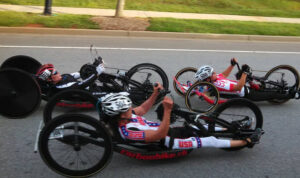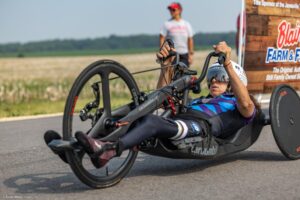Most of us can remember getting our first bike as a kid—it was pretty much the best gift you could get! But if you have a child with special needs or different abilities, adaptive cycling options were limited or simply nonexistent.
Thankfully, children of all abilities can enjoy the rush of cycling with adaptive bikes and other cycling equipment available today. Learn more about the types of adaptive bikes available on the market today and 6 factors to keep in mind when you buy adaptive cycling equipment.
The 4 types of adaptive cycling bikes
There’s a wide variety of specialized, adaptive cycles that can suit just about everyone. There are 4 main types of adaptive bikes, although the right one for your situation will depend on your specific needs.
- Handcycles
Just like the name implies, you power a handcycle with your arms instead of your legs. Handcycles are more popular with riders who have limited or no lower mobility, but they’re also a great option for people who want to rebuild their upper body strength.
Handcycles come in different styles and seating positions to ensure a comfortable ride for the driver. Bike-On is proud to offer a wide variety of handcycles to suit your needs, including the Quad Elite handcycle line, which we designed with quadriplegic cyclists in mind.
- Trikes
Trikes have three wheels, so the rider doesn’t have to worry about balancing as they cycle. You can also fit a trike adaptive bike with clipless pedals. These footplates lock your shoes to the pedal, which makes it much easier for the rider to rotate the pedals. The trike style is helpful for cyclists with learning disabilities or for cyclists who are recovering from injury.
- Tandem
Tandem adaptive bikes are designed for two people to ride together. They usually come with two or three wheels, although some styles have four. Tandem cycles allow both riders to pedal together, which is perfect for riders who might not have the strength to power the cycle alone.
- Wheelchair cycles
Wheelchair cycles have a seat on the front of a cycle and a separate seat for the driver. This allows the driver to have a view of the road as well as their passenger. This option is ideal for those with disabilities like complete paralysis.
Some styles—like the split-frame OPair by Van Raam—actually allow you to remove the wheelchair from the cycle frame, which means you can use the wheelchair separately once you’re on location. Many wheelchair cycles also offer a power assist option, which can be helpful for the driver.
6 factors to consider when purchasing an adaptive bike
Adaptive bikes make cycling accessible for riders of all abilities. But they’re a big investment, so you want to make sure you’re making the right choice. Consider these factors to find the perfect bike for your situation:
- Head support: Some riders may need additional head support, so if that’s the case, you’ll want to make sure this is either standard or offered as an accessory for the model you buy.
- Postural support: As with head support, some riders have different requirements when it comes to postural support. You’ll find that there is a range across manufacturers and models, so you’ll be able to choose the right one for you. For example, our Freedom Concepts line offers some of the best postural support features in the industry.
- Handlebars: Wide and loop handlebars are the two styles you’ll see most often on adaptive bikes. Wide handlebars have the more traditional “U” shape, while the loop style offers more comfortable hand positioning and control for riders.
- Electronic assistance: There are so many ways you can modify your bike with electronic assistance. Automatic gear shifting, power assist, and reciprocators can all help users with limited mobility enjoy the benefits of cycling.
- Measurement: Measurements differ by manufacturer, so always check the specs before you buy! You want to select an appropriately sized bike, so check the measurements before you purchase an adaptive bike.
- Cost: Adaptive bikes can be expensive, and the cost can be challenging for people living with a disability. Check with your insurance provider first to see if an adaptive bike is covered under your policy. If not, grant programs may be able to help you. We’ve provided a great list of resources to help you find the right funding option for you.
We all know exercise is the key to staying healthy. There are so many physical, mental, and emotional benefits to getting regular exercise, and it’s important for everyone to find an activity that they love to do.
Adaptive cycling is a great option because it’s accessible for just about everyone—as long as you have the right equipment. If you’re in the market for an adaptive bike, get in touch with Bike-On’s adaptive cycling experts. We’re here to answer your questions and help you find the style that best fits your needs.






